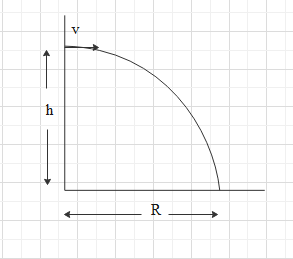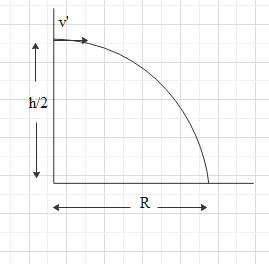
A body projected horizontally with a velocity $v$ from a height $h$ has a range $R$. With what velocity this body has to be projected horizontally from a height $\dfrac{h}{2}$ to have the same range?
A. $\sqrt 2 v$
B. $2v$
C. $6\,v$
D. \[8\,v\]
Answer
218.4k+ views
Hint: We can use the equation of motion for vertical displacement and horizontal displacement to find the answer. In the vertical displacement there is acceleration due to gravity. Whereas in the horizontal direction there is no acceleration due to gravity. Using this we can find the equation for range and height for both the cases. Then by comparing the equations we can find the final velocity with which it should be projected for getting the same range.
Complete step by step answer:
It is given that a body is projected horizontally from a height h with a velocity v.
The range is R.
We need to find the velocity of this body when it is projected from a height $\dfrac{h}{2}$ such that it has the same range.
Consider the figure given below

Height h is the vertical displacement.
We know the second equation of motion given as
$s = ut + \dfrac{1}{2}a{t^2}$
Where, s is the displacement, u is the initial velocity, t is the time taken, a is the acceleration.
So, the equation for the vertical displacement can be written as
$h = 0 \times t + \dfrac{1}{2}g{t^2}$
Here the velocity in y direction can be taken zero initially because the body is projected horizontally so there is only velocity in x direction.
$ \Rightarrow h = \dfrac{1}{2}g{t^2}$ (1)
Now let us write the equation of motion for the horizontal displacement which is the range R .
The acceleration due to gravity acts only in the vertical direction hence in this case g can be taken as zero.
$ \Rightarrow R = vt + 0$
$ \Rightarrow R = vt$
$ \Rightarrow t = \dfrac{R}{v}$ (2)
Now substituting the value of t from equation to in equation 1 we get
$ \Rightarrow h = \dfrac{1}{2}g{\left( {\dfrac{R}{v}} \right)^2}$ (3)
Now let us analyze the second case. Let the velocity with which it is projected is $v'$ .

The equation for vertical displacement can be written as
$\dfrac{h}{2} = 0 \times t' + \dfrac{1}{2}g{t'^2}$
$ \Rightarrow \dfrac{h}{2} = \dfrac{1}{2}g{t'^2}$ (4)
The equation for the horizontal displacement can be written as
$R = v't' + 0$
$ \Rightarrow R = v't'$
$ \Rightarrow t' = \dfrac{R}{{v'}}$ (5)
Substituting the value of $t'$ in equation 4 we get
$ \Rightarrow \dfrac{h}{2} = \dfrac{1}{2}g{\left( {\dfrac{R}{{v'}}} \right)^2}$ (6)
Now let us divide equation 3 by equation 6.
Then we get
$ \Rightarrow \dfrac{{2h}}{h} = \dfrac{{\dfrac{1}{2}g{{\left( {\dfrac{R}{v}} \right)}^2}}}{{\dfrac{1}{2}g{{\left( {\dfrac{R}{{v'}}} \right)}^2}}}$
$ \Rightarrow 2 = {\left( {\dfrac{{v'}}{v}} \right)^2}$
$ \Rightarrow \sqrt 2 = \dfrac{{v'}}{v}$
$\therefore v' = v\sqrt 2 $
This is the value of velocity with which it should be projected for getting the same range $R$ at a height $\dfrac{h}{2}$.
So, the correct answer is option A.
Note: Always remember that gravity will accelerate a body only in the vertical direction. Gravity will not pull a projectile sideways. It will only pull in the downward direction. So, while writing the equation of motion for the horizontal displacement the acceleration due to gravity should be taken as zero.
Complete step by step answer:
It is given that a body is projected horizontally from a height h with a velocity v.
The range is R.
We need to find the velocity of this body when it is projected from a height $\dfrac{h}{2}$ such that it has the same range.
Consider the figure given below

Height h is the vertical displacement.
We know the second equation of motion given as
$s = ut + \dfrac{1}{2}a{t^2}$
Where, s is the displacement, u is the initial velocity, t is the time taken, a is the acceleration.
So, the equation for the vertical displacement can be written as
$h = 0 \times t + \dfrac{1}{2}g{t^2}$
Here the velocity in y direction can be taken zero initially because the body is projected horizontally so there is only velocity in x direction.
$ \Rightarrow h = \dfrac{1}{2}g{t^2}$ (1)
Now let us write the equation of motion for the horizontal displacement which is the range R .
The acceleration due to gravity acts only in the vertical direction hence in this case g can be taken as zero.
$ \Rightarrow R = vt + 0$
$ \Rightarrow R = vt$
$ \Rightarrow t = \dfrac{R}{v}$ (2)
Now substituting the value of t from equation to in equation 1 we get
$ \Rightarrow h = \dfrac{1}{2}g{\left( {\dfrac{R}{v}} \right)^2}$ (3)
Now let us analyze the second case. Let the velocity with which it is projected is $v'$ .

The equation for vertical displacement can be written as
$\dfrac{h}{2} = 0 \times t' + \dfrac{1}{2}g{t'^2}$
$ \Rightarrow \dfrac{h}{2} = \dfrac{1}{2}g{t'^2}$ (4)
The equation for the horizontal displacement can be written as
$R = v't' + 0$
$ \Rightarrow R = v't'$
$ \Rightarrow t' = \dfrac{R}{{v'}}$ (5)
Substituting the value of $t'$ in equation 4 we get
$ \Rightarrow \dfrac{h}{2} = \dfrac{1}{2}g{\left( {\dfrac{R}{{v'}}} \right)^2}$ (6)
Now let us divide equation 3 by equation 6.
Then we get
$ \Rightarrow \dfrac{{2h}}{h} = \dfrac{{\dfrac{1}{2}g{{\left( {\dfrac{R}{v}} \right)}^2}}}{{\dfrac{1}{2}g{{\left( {\dfrac{R}{{v'}}} \right)}^2}}}$
$ \Rightarrow 2 = {\left( {\dfrac{{v'}}{v}} \right)^2}$
$ \Rightarrow \sqrt 2 = \dfrac{{v'}}{v}$
$\therefore v' = v\sqrt 2 $
This is the value of velocity with which it should be projected for getting the same range $R$ at a height $\dfrac{h}{2}$.
So, the correct answer is option A.
Note: Always remember that gravity will accelerate a body only in the vertical direction. Gravity will not pull a projectile sideways. It will only pull in the downward direction. So, while writing the equation of motion for the horizontal displacement the acceleration due to gravity should be taken as zero.
Recently Updated Pages
Chemical Properties of Hydrogen - Important Concepts for JEE Exam Preparation

JEE General Topics in Chemistry Important Concepts and Tips

JEE Atomic Structure and Chemical Bonding important Concepts and Tips

JEE Amino Acids and Peptides Important Concepts and Tips for Exam Preparation

JEE Extractive Metallurgy Important Concepts and Tips for Exam Preparation

Algebra Made Easy: Step-by-Step Guide for Students

Trending doubts
JEE Main 2026: Application Form Open, Exam Dates, Syllabus, Eligibility & Question Papers

Derivation of Equation of Trajectory Explained for Students

Hybridisation in Chemistry – Concept, Types & Applications

Understanding the Angle of Deviation in a Prism

Understanding Collisions: Types and Examples for Students

Understanding Atomic Structure for Beginners

Other Pages
JEE Advanced Marks vs Ranks 2025: Understanding Category-wise Qualifying Marks and Previous Year Cut-offs

Units And Measurements Class 11 Physics Chapter 1 CBSE Notes - 2025-26

NCERT Solutions For Class 11 Physics Chapter 8 Mechanical Properties Of Solids

Motion in a Straight Line Class 11 Physics Chapter 2 CBSE Notes - 2025-26

NCERT Solutions for Class 11 Physics Chapter 7 Gravitation 2025-26

How to Convert a Galvanometer into an Ammeter or Voltmeter




